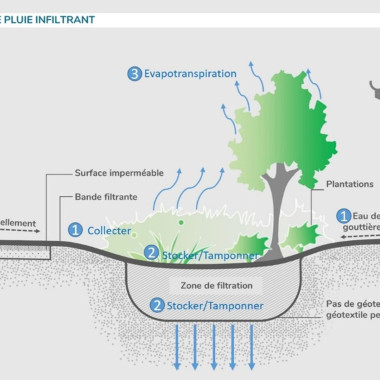Water Smart Cities Project
Article

Article

Microplastics (MP) are plastic particles between 0.1 µm and 5 mm in size that result from the degradation of larger plastic products or products designed specifically on a microscopic scale. They are found in oceans, groundwater and surface water and can be ingested by certain aquatic animals and accumulate in the trophic chain. As a result, they represent a major issue for human health and the environment.
A study published in 2018 in the United Kingdom showed that the quantity of PM present in receiving waters was greater downstream of each of the six wastewater treatment plants (WWTPs) studied, thus confirming that wastewater effluent - even treated effluent - is a source of PM in the aquatic environment. Other major sources of PM in the environment have been identified: sewage sludge applied to agricultural land, run-off water and aerial deposition.
It is estimated that 10-20% of total PM arrives at WWTPs.
Most of the PM found in wastewater treatment plants comes from fibres (polyester and nylon) emitted during the washing of textiles and microbeads from cosmetics.
The current design of WWTPs makes it possible to remove on average between 40 and 99.9% of PM from wastewater, depending on the treatment processes used. As shown in Figure 1, removal takes place during the various stages of treatment, and most of the PM treated ends up in the by-products and sewage sludge. Removal performance depends on a number of factors, including the size, nature and concentration of the PM, the presence of fatty matter, the treatment processes and their sizing, rainfall, and so on. It should be noted that the measurement methods and units used to quantify PM are not standardised.
The majority of PM is eliminated during pre-treatment and primary treatment (50 to 98%). These stages generally eliminate the largest particles (1000 to 5000 µm), which are mainly the fibres trapped in the flocs and the microbeads floating on the surface. The presence of a degreaser and the injection of coagulant increase the capacity to eliminate PM. The type of coagulant has an impact on the removal rate.
During secondary treatment, which generally involves biological treatment followed by clarification, residual PM is trapped in flocs and biofilms, which are eliminated by sedimentation/sludge purging and skimming in the clarifier. At the end of this stage, there are no more PM larger than 500 µm and the overall PM removal efficiency regularly exceeds 85%. At this stage, the formation of biofilms around the particles is an important mechanism that modifies the surface properties and relative density of the PM. Contact time is therefore an important factor in their elimination. Effluent treatment using a membrane bioreactor (MBR) provides excellent elimination yields (99.9%).
Tertiary treatments provide an additional barrier, enabling 98-99.9% removal of PM from wastewater. Their effectiveness depends on the process used (disc filter, sand filtration, flotation, etc.). The residual fractions found in effluents after these treatments are fragments of 20 to 190 µm, mainly made up of fibres that pass longitudinally through the filters.
PM removed from wastewater is found in screenings, grease, sand and sewage sludge. The figures given for the concentration of PM in sludge vary widely from one study to another. Values range from 1,500 to 170,000 PM/Kg of dry matter.
Coagulation-flocculation eliminates some of the PM by destabilising and trapping the particles. One study showed that the use of aluminium salts eliminated nearly 37% of PM smaller than 500 µm. Another study showed 90% removal of microbeads by electrocoagulation.
As for filtration, membrane techniques (micro, ultra and nanofiltration) eliminate PM with 95% efficiency. Granular activated carbon (GAC) filters have eliminated 61% of the PM contained in effluent from an urban wastewater treatment plant.
Advanced oxidation processes (AOP), generally used for the degradation of recalcitrant organic compounds, have been shown to eliminate up to 50% of PM depending on various reaction parameters (dose and type of catalyst, PM concentration, temperature).
Alongside these tried and tested techniques, new processes are emerging. These include, for example, the use of algae as specific adsorbents to agglomerate PM into denser aggregates, or the use of porous structures such as ‘organometallic frameworks’ or hydrogels to trap PM.
It is currently estimated that 10 to 20% of the PM emitted into the environment passes through wastewater treatment plants. These PM are essentially fibres from washing textiles and microbeads from cosmetics.
Conventional urban wastewater treatment plants have the capacity to remove an average of 40 to 99.9% of PM from wastewater, depending on the processes used. More than 50% of PM is eliminated during pre-treatment and primary treatment (skimming and sedimentation). At the clarifier outlet, less than 15% of the PM initially present in the wastewater generally remains and, depending on the processes used, tertiary treatment can achieve an overall elimination efficiency of 99.9%.
In traditional processes, the PM removed from wastewater is concentrated in the by-products of the plants (sand, grease and sludge).
Research into the specific elimination of PM is focusing mainly on selective techniques for isolating or degrading PM directly.
Article

Article

Event
